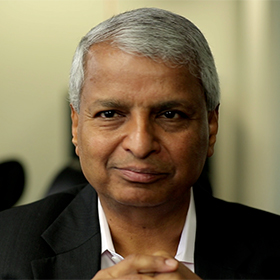 In business, venture capitalist and entrepreneur Gururaj "Desh" Deshpande focuses on innovations that create real impact, and he's brought that mindset to his philanthropy. Creating impact is the mission of the MIT Deshpande Center for Technological Innovation, one of Deshpande's many philanthropic achievements.
In business, venture capitalist and entrepreneur Gururaj "Desh" Deshpande focuses on innovations that create real impact, and he's brought that mindset to his philanthropy. Creating impact is the mission of the MIT Deshpande Center for Technological Innovation, one of Deshpande's many philanthropic achievements.
"Problems need new approaches, and...so you need innovators; and innovators, for them to think about new things you have to create a nurturing environment," he says. "You have to have a place where people can congregate and discuss and come up with new ideas." The MIT Deshpande Center for Technological Innovation gives MIT researchers a haven in which to develop innovative technologies in areas such as tissue engineering, semi-conductors, wireless, and so on.
Deshpande says that the center avoids the all-too-common practice of having insulated researchers create innovations that have little relevance for the problems of the real world. How? By having a structure that connects the "thinkers to [the] doers." Deshpande says that when a member of the faculty comes up with an idea, he or she can apply to the center to help that idea get a "bridge" to the world outside of academia. Catalysts, which are young venture capitalists and entrepreneurs with domain expertise, and teams of expert volunteers help to make this bridge happen. Deshpande says the resulting breakthrough products and new companies help solve large-scale problems in health, information technology, energy, and other fields.
See a complete archive of Desh Deshpande's videos.
"In the last 10 years, we have funded about 90 projects, we have given out about $10 million dollars, and 26 of these have become companies and have collectively raised about $400 million," says Deshpande. "It's a process that works." It's also a process that Deshpande is working to foster in governments and institutions around the world.
Desh Deshpande's Key Messages for Philanthropists
- Start with the problem, not the solution. Watch: Reverse engineering: Desh Deshpande’s Social Innovation Sandbox in India starts with the problem, not with the solution.
- Realize the best solutions come from “catalyzing” not “designing.” Watch: Bring an open mind: Desh Deshpande says the best solutions come from “catalyzing” not “designing.”
- Learn from India on how to create “low cost, scalable solutions.” Watch: "We price ourselves out of impact”: Desh Deshpande takes US nonprofit leaders to India to share a key observation.
- Consider working with governments on large-scale collaborative efforts. Watch: Tapping government resources: Desh Deshpande’s thoughts on efficiently scaling impact for large populations.
- Make research relevant. Watch: Connecting the thinkers to doers: Desh Deshpande explains how his MIT center boosts the impact of new innovations.
A number of projects and other measures of impact are from the time of the interview; see the Deshpande Center site for most recent information.


